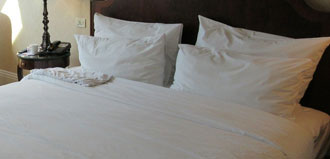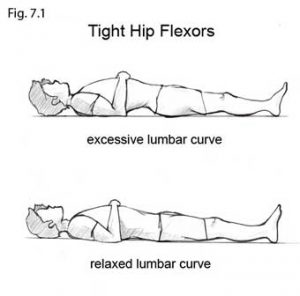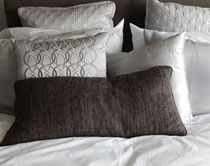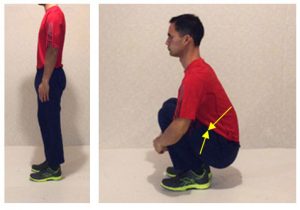10 Tips For Back Pain Relief When You Sleep
By Sherwin Nicholson | Updated May 7, 2020

Need to get through the night without pain? Here are tips for tonight.
When you have lower back pain, your sleep is usually poor. You frequently wake up often with morning stiffness and many episodes of stiffness and discomfort.
It’s bad enough when you are healthy and you lose sleep. But when it also hurts, it robs you of your ability to enter the deeper and restful state.
Without deep sleep, your body won’t repair and heal efficiently. This slows down the healing process for your spine and the muscles that support it, which you don’t want to sacrifice.
Watch out for the warning signs:
Be careful as your symptoms can begin from a dull, deep sensation or a very tight & stiff feeling (involving both the back and hips) to eventually a sharp, tingling sensation radiating down either leg.
These symptoms can be from severe discs issues, facet joint irritation, nerve root impingement, sciatica, piriformis syndrome and strained muscle injury imbalances.
If you are in need of help, follow these immediate steps:
1. Use a moderately soft to a moderately firm bed for relief
Most likely your bed should be adequate but there comes a time where some parts of the bed can fail. Check the bed tonight to see if there are any spots that sag. Especially around the area where your waist and buttocks rests.
The bed will appear flat before you lie on it but after lying on it for a while, some parts over compress and give. You’ll wake up in this sag, even sorer than when you got in.
Specialists usually recommend a firm mattress. However, this is generally true for prevention. The best candidates are those who are flexible, relaxed and have few symptoms. If you already have pain, a softer bed may help to cushion and absorb the stiffness that your body currently has.
Although a firm mattress is ideal, changing to one now may or may not be practical. If it’s not convenient or affordable right now, the following may help.
2. Sleep on your side and not on your front (or back)

It is NEVER a good idea for you to be on your front (stomach) unless your back is pain-free or if there is a medical condition that requires you to lie down in this way.
It is also better not to be on your back for now if it is already very tight and if your lumbar curve it excessive. Doing so will cause even more irritation and pain.
Most people have this very problem.
Check it out for yourself! Go lie down on a flat surface as seen in figure 7.1. If you have an arch under your lumbar curve so severe that you can drive a truck under, you have found a BIG problem for why you can’t sleep well!
What is ideal is to be able to feel the floor or carpet just under your curve immediately as you lie.
Lying on your back can either cause or exacerbate an anterior pelvic tilt, that worsens disc and facet joint pain.
As seen in figure 7.1, it causes your tightened iliopsoas muscle to pull on your lumbar discs, thereby, creating the visible arch as seen.
When you are able to stretch out and relax these areas, only then will your lumbar curve be relaxed. Stretching your tight areas will help you lie down in any position.
3. Add lumbar support when necessary

If you don’t have an arch while lying down, lumbar support will help.
If you are the type that has more of a posterior pelvic tilt and shortened hip flexors (ex. slouching while seated), you may not have an arch when you lie down.
However, as you do lie down, your hip flexors will pull on your lumbar spine and create the same tension and discomfort as well. Use a small cushion to support a slight arch under your lumbar curve.
To help relieve the source of tension, use a small cushion to support a small arch under your lumbar curve.
If you have pain, the chances are you have an excessive lumbar arch when you stand. As you lie down, it becomes tighter as your back tries to relax (straighten out).
If you don’t have an arch and it still hurts you, a cushion will ease any pull your iliopsoas may have on your pelvis that causes tightening. It also reduces any swelling from disc injury.
4. Add knee/leg support to keep them open
Always place a cushion/pillow between your knees. It keeps the knees apart and helps to relieve pressure off of the pelvis. Using a support underneath your knees is a great option. This help by relaxing your pelvis helps to reduce the same pull experienced in tip#3.
5. Keep your knees bent at all times
If you must fall asleep on your back, use 1-2 pillows underneath your knees to help keep them in a bent position. Bending helps to tilt the pelvis towards posterior and reduce pressure due to anterior pelvic tilt. By maintaining bent knees, you also help to reduce the pelvic tilt experienced in tip#3. Again, this tip is for those who must be in this position instead of on their side.
6. Sleep on the couch or against a wall to control your position

use your trusted couch to lie sideways
If you find that you are rolling from your side, then onto your back, you will need to have a support. Use the upright support of the couch or a wall to remain on your side. It will keep you from rolling so you can stay asleep uninterrupted.
If you have a bed that can be pushed against the wall, you can sleep so that your back rests against it. This will help to keep you from rolling onto your back which is much less ideal.
This approach, of course, is only temporary as your bed should be the primary choice.
7. Keep your room warm as you sleep
Don’t sleep with the temperature down. It can make you feel too cold and reduce your circulation. Colder temperatures can make you stiffer and more uncomfortable at night. It also makes you prone to spasm due to your muscles tightening in response to the temperature change.
8. Dress comfortably for bed
Don’t under dress. You will feel colder and may have more frequent spasms or even tightness. Comfortable clothing will help you to feel warmer and will improve circulation to your back.
Don’t forget to dress comfortably when your spending anytime in the cold too. For example, after spending any amount of time out during the winter season.
You won’t notice at first, but just a short amount of time in the cold will quickly make your joints stiff. You won’t notice it because you’re cold. By the time you’re in bed, your muscles are already tense.
By the way, also make sure that your clothing is loose fitting during the day. Choose stretchable pant wear or dress one size larger to avoid restricting the movement of your hips.
9. Practice relaxation before bedtime
Do’s and Don’ts:
- Avoid strenuous workouts and activities that can tighten your back
- Minimize chronic couch sitting as they provide the least support
- Stretch more to help reverse any overnight tightness that develops
- Take a warm bath or shower to relax and boost circulation to all of your muscles
Follow these recommendations before bed. Your goal is to prepare your body for bed via relaxation and not from exhaustion.
For some, their symptoms begin to feel better towards the night and worse in the morning.
There are some very useful tips for morning pain. By relaxing before bed, your chances of a full and restful night are better.
10. And of course, exercise & stretching, but this way instead
The above 9 suggestions are merely part of the solution.
This site is here to help those with pain build a greater awareness of many of the strategies required to help overcome their struggle.
Retraining your muscles and joints to function more effectively is equally if not more. When you become properly retrained and reconditioned, you’ll sleep much better.
Back pain due to mechanical issues such as disc or vertebrae injury can worsen your body’s ability to regain balance. Muscle balance is what is necessary to prevent disc failure and joint injury. If it is not corrected properly, the imbalances will remain, making disc repair poor.
To test whether or not muscle imbalances are the reason, it is helpful to try these 10 Exercises for Relief. Perform them as instructed slowly and carefully. If you find any relief, then some of your struggle is the result of poor muscle conditioning. Most of us have poor muscle conditioning that can hurt our backs.
The Deep Squat Rest
The Deep Squat Rest is one of the best methods to test if your muscles and joints are worsening your pain when trying to lie down or go to bed. It will test the degree to which your tightness and stiffness affect your hip and flexibility. If you are too tight to complete this movement then you will have issues with adequate sleep.
This is an important exercise to perform both prior to bedtime and just after awakening as it helps to reduce the progressive tightening of your hips throughout the course of the day. Tight and immobile hips will compromise lumbar flexibility leading to discomfort.
If you liked this article, you’ll also like:
Help to sleeping better in the night
A great and easy stretch for the morning
When sciatica is affecting your bedtime
References:
- www.mayoclinic.com
- Treat Your Own Back – 2011. Robin McKenzie. Gordon Soules Publishers. 9th Edition. www.gordonsoules.com
- www.backcarecanada.ca
- Early Management of Persistent Non-specific LBP. NICE Clinical Guidelines, No. 88 http://www.ncbi.nlm.nih.gov/pubmedhealth/PMH0005442/
Additional references for this page

